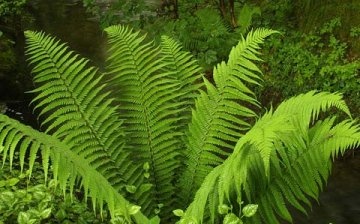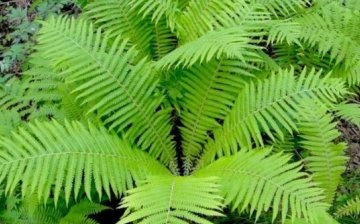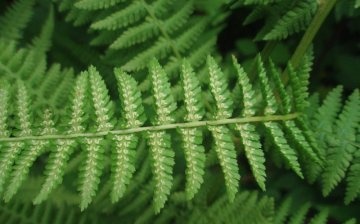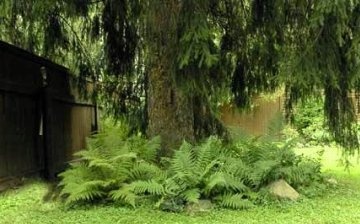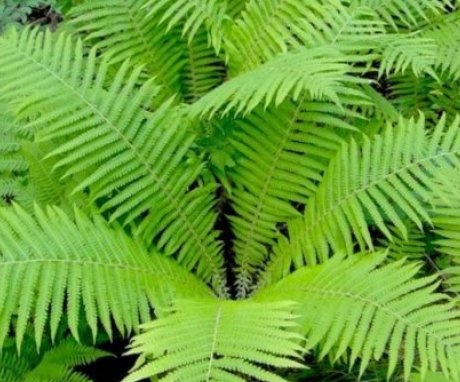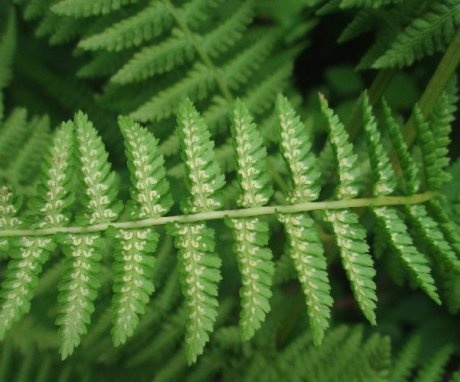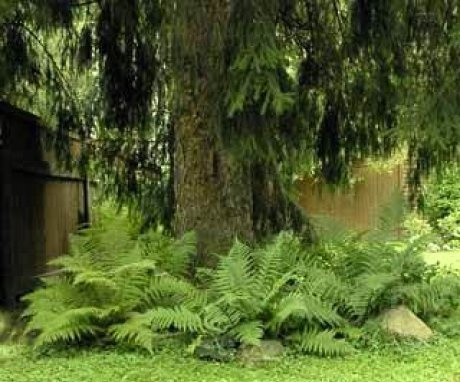Kochedzhnik female - unpretentious fern for the garden
A female kochedzhnik is a long-term fernthat grows in Eurasia, America, Africa and even Russia. The plant thrives in a forest belt, loves acidic soil and shaded areas. The plant can reach 1 meter 20 centimeters in height, the bushes are very spreading and beautiful.
Kochedzhnik is easy to recognize by the carved leaves that moose often eat. They are dark green in color and have excellent decorative properties. The plant has a rather powerful root system, which is covered with numerous scales. Unlike other fern species, the cochid fern does not bloom.
Content:
- Reproduction and planting
- Basic rules of care
- Procurement of material for use in traditional medicine
- The use of kochedyzhnik for medicinal purposes
- Decorative properties of kochedzhnik
Reproduction and planting
Reproduction should start in spring or autumn. In order to obtain offspring by dividing the roots, it is necessary to cut the roots into fragments, each of which must have a bud. The shoots are planted in a hole 20 cm deep. The distance between the plants should be at least 60 cm. For the winter, young plants should be covered with spruce branches.
Reproduction of the kochedzhnik occurs by self-seeding (spores) or by dividing the roots.
In order to propagate a kochedyzhnik by means of spores, you need to treat them with a potassium solution and plant them in shallow containers with soil moistened with boiled water. Cover the seedlings with a glass lid on top. After the seedlings get stronger, they can be transplanted into open ground.
Landing rules for a kochedyzhnik:
- To plant a kochedyzhnik, it is necessary to divide the roots of the plant into parts.
- The soil is carefully dug up and humus is added, and wood ash.
- For heavy soil, you can dilute it with river sand.
- The diameter of the planting hole is determined according to the size of the seedling.
- After the seedling is placed in the hole, it must be tamped, mulch the soil around it and water it well.
- The soil around the kochedyzhnik must be weeded and loosened.
From the second year, the plant practically does not need watering, if only in severe drought. Otherwise, the leaves of the plant will turn brown, but it is unlikely that it will die, as it is highly resistant to dry weather.
Basic rules of care
Kochedzhnik is perhaps the most unpretentious plant that does not require special care. Already from the second year, the kochedyzhnik is practically not susceptible to attacks pests and tolerates winter well. The only thing that can help you survive the winter more comfortably is pruning dead leaves and mulching the soil around the plant.
Kochedzhnik loves shade, so you should not plant it in a brightly lit area.
Otherwise, the fern will stop growing and become completely unsightly. The soil should be fertile enough and good oxygen permeability. You need to feed the plant only if the soil is very depleted. Kochedzhnik does not like sudden changes in temperature and strong gusts of wind, as he is able to break the stems of the plant.The fern does not require frequent transplants, it is enough to do it once every 15 years.
Pests and diseases that can be attacked by the cochiner:
- Fungal diseases that cause leaf spot. As a rule, you can escape from them with the help of fungicides.
- Slugs that can eat the leaves of the plant. The most effective method of pest control is manual collection and mulching of the soil with coniferous needles.
Procurement of material for use in traditional medicine
How to properly prepare the roots of kochedyzhnik for use in alternative medicine:
- The period for collecting the roots for drying is autumn.
- Next, they must be cleaned of dry and rotten processes.
- Dry the roots in the shade.
The roots retain their healing properties for three months after drying. You can check the freshness of the roots by breaking: green color will indicate a quality product, and brown color - stale.
How to properly prepare kochedyzhnik leaves for use in alternative medicine:
- When collecting leaves, you need to pay attention to their length, since it should not be more than 25 cm.
- The leaves are tied in small bunches and placed in boiling saline for 7 seconds.
- The processed leaves are hung to dry in the sun.
The finished material should rustle and bend, but not break. It should be stored in cloth bags in a dry, dark place.
The use of kochedyzhnik for medicinal purposes
How can you use kochedyzhnik in folk medicine:
- The decoction and baths with its addition are used to treat childhood epilepsy.
- For gastrointestinal disorders, a decoction is also taken.
- In addition, it is good for flu, bronchitis and nephritis.
- Tincture of kochedyzhnik on alcohol is used for uterine bleeding.
- A decoction of the rhizomes of the cochinacea is used as an antihelminthic agent.
There are several nuances that you should pay attention to before using:
- Since the components in the kochedyzhnik are fat-soluble, the simultaneous use of the drug and fatty foods can cause overdose and poisoning.
- Poisoning proceeds with the following symptoms: nausea and vomiting, abdominal pain, dizziness, decreased visual activity.
- It is categorically contraindicated for pregnant and lactating women to consume kochedzhnik.
At the first symptoms of poisoning, you should immediately consult a doctor.
Decorative properties of kochedzhnik
Kochedzhnik is an edible plant and can be eaten. To do this, cut off the May, young and not yet opened leaves. The stems from such leaves are eaten. So that the fern does not taste bitter, it is boiled and washed in water up to three times. Such leaves can be used as an addition to soups, or as a vegetable side dish.
Kochedzhnik is able to give a certain zest to any garden.
Basically, it is planted away from the bright sun, decorating gazebos, fountains, alpine slides, or diluting plantings with trees. You can use a group planting and dilute it with more contrasting plants, creating a mini fern garden.
Fern often used as an individual planting, in order to emphasize all the beauty and spreading of the plant. Snowdrops are considered good neighbors for the kochedzhnik, since after flowering their stems turn yellow and die off, and the kochedzhnik is able to cover up their unsightly appearance. In any case, the kochedzhnik will look favorably on almost any personal plot, decorating and enlivening the landscape.
More information can be found in the video:



